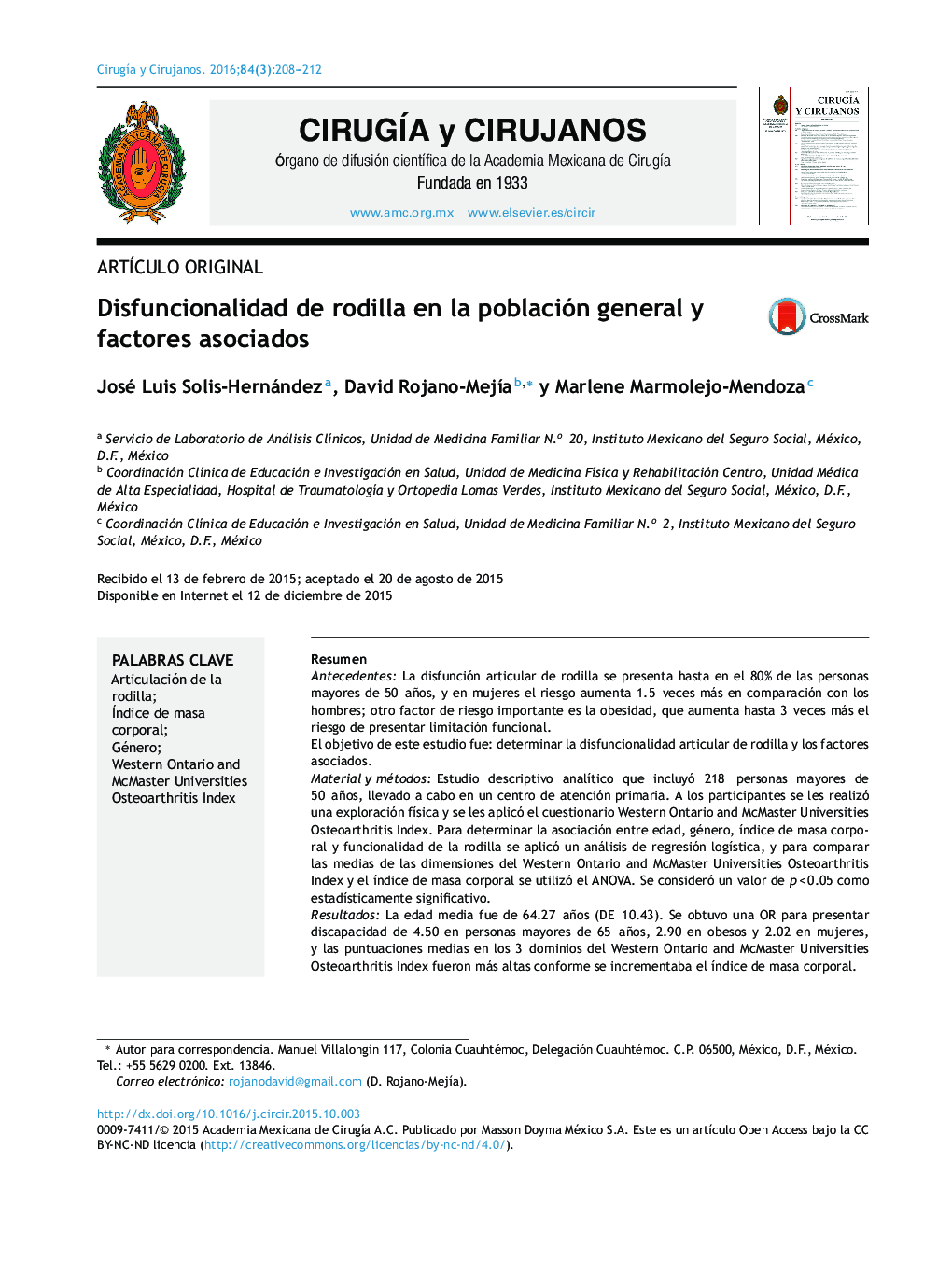| Article ID | Journal | Published Year | Pages | File Type |
|---|---|---|---|---|
| 4283165 | Cirugía y Cirujanos | 2016 | 5 Pages |
ResumenAntecedentesLa disfunción articular de rodilla se presenta hasta en el 80% de las personas mayores de 50 años, y en mujeres el riesgo aumenta 1.5 veces más en comparación con los hombres; otro factor de riesgo importante es la obesidad, que aumenta hasta 3 veces más el riesgo de presentar limitación funcional.El objetivo de este estudio fue: determinar la disfuncionalidad articular de rodilla y los factores asociados.Material y métodosEstudio descriptivo analítico que incluyó 218 personas mayores de 50 años, llevado a cabo en un centro de atención primaria. A los participantes se les realizó una exploración física y se les aplicó el cuestionario Western Ontario and McMaster Universities Osteoarthritis Index. Para determinar la asociación entre edad, género, índice de masa corporal y funcionalidad de la rodilla se aplicó un análisis de regresión logística, y para comparar las medias de las dimensiones del Western Ontario and McMaster Universities Osteoarthritis Index y el índice de masa corporal se utilizó el ANOVA. Se consideró un valor de p < 0.05 como estadísticamente significativo.ResultadosLa edad media fue de 64.27 años (DE 10.43). Se obtuvo una OR para presentar discapacidad de 4.50 en personas mayores de 65 años, 2.90 en obesos y 2.02 en mujeres, y las puntuaciones medias en los 3 dominios del Western Ontario and McMaster Universities Osteoarthritis Index fueron más altas conforme se incrementaba el índice de masa corporal.ConclusionesLas mujeres presentan mayor discapacidad que los hombres, haciéndose más evidente en edades avanzadas, y el riesgo de disfunción articular aumenta hasta 3 veces más en sujetos con obesidad.
BackgroundKnee joint dysfunction is present in 80% of people over 50 years of age, and in women there is a 1.5 times higher risk compared to men. Another important risk factor is obesity, which leads to a 3 times increase in the risk of suffering functional limitations in the joint.The aim of this study was to determine knee joint dysfunction and the associated factors.Material and methodsAn analytical and descriptive study was conducted on 218 individuals older than 50 years of age in a primary care centre. A physical examination was performed on each patient, and the Western Ontario and McMaster Universities Osteoarthritis Index questionnaire was applied to them all. Logistic regression analysis was used to determine the association between age, gender, body mass index, and knee function. ANOVA was used to compare the means of the Western Ontario and McMaster Universities Osteoarthritis Index scores and body mass index measurements. A p < 0.05 was considered statistically significant.ResultsThe mean age was 64.27 years (SD 10.43). An OR of 4.50 was obtained for having a disability in people over 65 years of age, 2.90 in obese people, and 2.02 in women. The mean scores in the 3 domains of Western Ontario and McMaster Universities Osteoarthritis Index were higher as the body mass index increased.ConclusionsWomen have greater disability than men, becoming more evident in older ages, and other risk of joint dysfunction increases up 3 times in obese patients.
